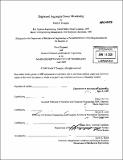Shipboard aggregate power monitoring
Author(s)
Douglas, Keith P. (Keith Preston)
DownloadFull printable version (34.48Mb)
Other Contributors
Massachusetts Institute of Technology. Dept. of Mechanical Engineering.
Advisor
Robert W. Cox and Steven B. Leeb.
Terms of use
Metadata
Show full item recordAbstract
Modem naval warships rely on vast arrays of sensor networks to evaluate the performance of mission critical systems. Although these sensor networks enable increased levels of automation, they are costly to install and to maintain. The power distribution network offers an alternative solution for tracking the performance of mission critical systems. Research conducted at Massachusetts Institute of Technology's Laboratory for Electromagnetic and Electronic Systems (LEES) has proven that the power distribution network contains vital information that can provide performance monitoring and automatic diagnostic functions. This thesis will address the issue of sensor-count reduction through the application of Non-Intrusive Load Monitoring (NILM) technology. Theoretical studies and field experiments will be presented in order to demonstrate the NILM's ability to correlate load activity with power measured from an aggregate level in the distribution system. Additionally, a critical evaluation is conducted on the current NILM configuration's ability to perform automated classification. Findings will be supported using data collected from NILMs monitoring power flow on board the U.S. Coast Guard Cutter ESCANABA (WMEC-907).
Description
Thesis (Nav. E. and S.M.)--Massachusetts Institute of Technology, Dept. of Mechanical Engineering, 2009. Includes bibliographical references (p. 96-100).
Date issued
2009Department
Massachusetts Institute of Technology. Department of Mechanical EngineeringPublisher
Massachusetts Institute of Technology
Keywords
Mechanical Engineering.